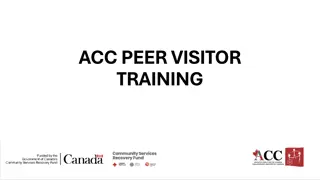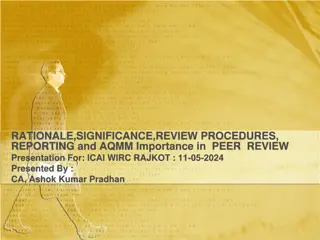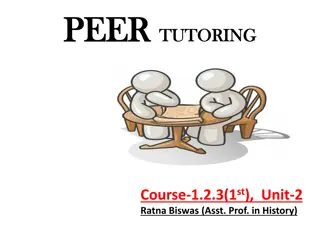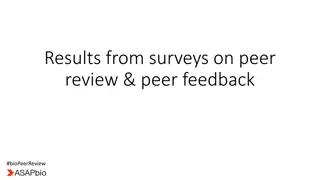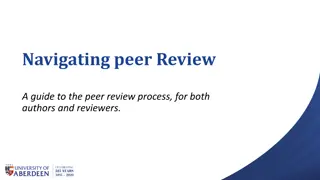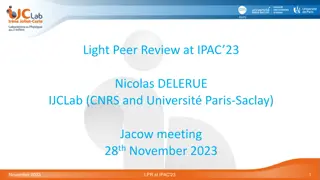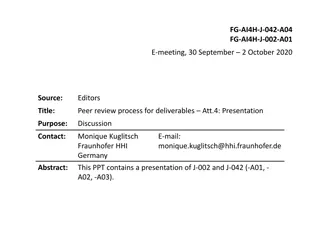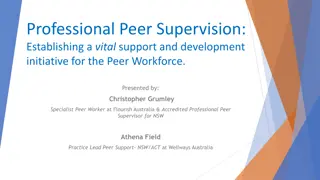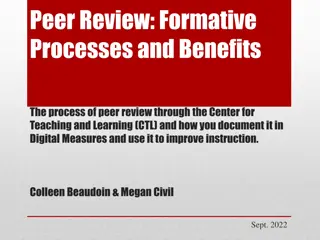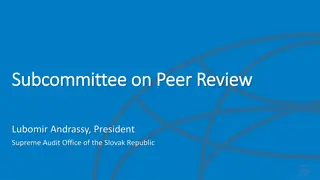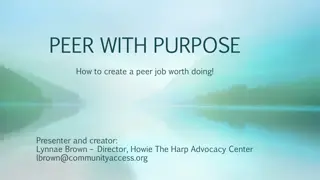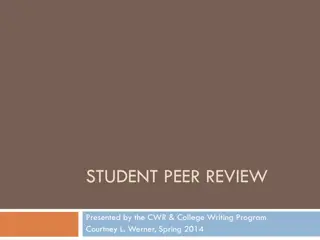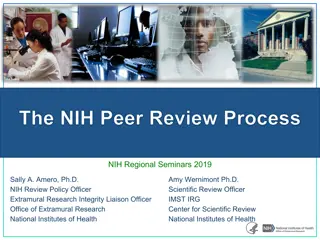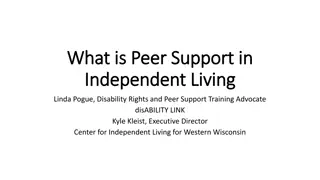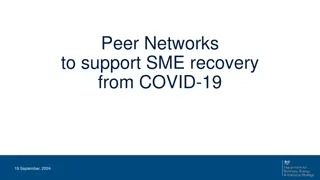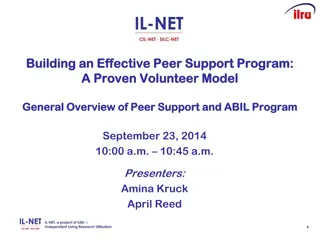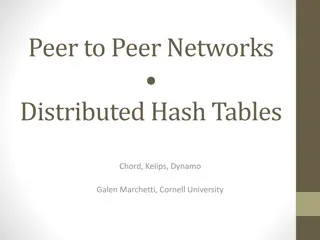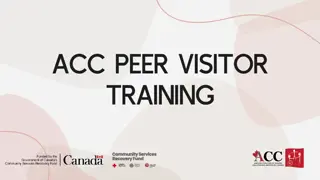Peer Review Essentials
Explore the importance of peer review in research, the benefits of being a reviewer, types of peer review processes, and basic principles to follow as a peer reviewer. Learn how to make initial impressions when reviewing papers effectively.
Download Presentation

Please find below an Image/Link to download the presentation.
The content on the website is provided AS IS for your information and personal use only. It may not be sold, licensed, or shared on other websites without obtaining consent from the author.If you encounter any issues during the download, it is possible that the publisher has removed the file from their server.
You are allowed to download the files provided on this website for personal or commercial use, subject to the condition that they are used lawfully. All files are the property of their respective owners.
The content on the website is provided AS IS for your information and personal use only. It may not be sold, licensed, or shared on other websites without obtaining consent from the author.
E N D
Presentation Transcript
Peer Review Essentials February 20, 2024 Timothy G. Murray, MD, MBA, FASRS Editor-in-Chief, JVRD Section Editors: Yoshihiro Yonekawa, MD, FASRS Aleksandra Rachitskaya, MD, FASRS
Agenda Overview of JVRD and review process What makes a good reviewer? Ethics Rewards
JVRD Overview: First issue launched: January, 2017 Indexed in PubMed Central: March, 2023 JVRD Podcast Series Launched: June, 2023
What is Peer Review? The peer review process is essential to the development of research We value the essential work of peer reviewers who ensure publication excellence and drive quality research. Filters out poor quality articles Assesses validity Maintains integrity of science
Why Should You Review? Help advance the field of retina Authors and researchers benefit from having their papers improved and their knowledge expanded. Stay current: be first to read cutting- edge research Improve your research and writing skills
Types of Peer Review Single blind peer review the name of the reviewer is hidden from the author Double blind peer review names are hidden from both reviewers and the authors Open peer review everyone is identified
Basic Principles of Peer Review Only agree to review manuscripts within your area of expertise that you can return in a timely manner Respect the confidentiality of the process Be objective and constructive in your review Declare all conflicts of interests Conflict of Interest Personal, professional, or financial relationship with any party involved in the manuscript.
So, youve agreed to review now what?
Initial Impressions Read the whole paper to get an initial impression before starting your in-depth review Meeting basic standards: Note: It is not the reviewer s job to proofread or suggest extensive grammatical revisions to a paper. If the meaning of the paper is lost due to extensive grammatical errors, recommend the paper for language editing. Assure the paper is relevant for JVRD by checking the Aims & Scope Does the paper give any indication of its quality threshold? Is this research significant within the field? Is the work novel? Is it original? Does it add to the subject area?
Initial Impressions Specifics to look for: Does the title reflect the subject of the paper? Do keywords reflect the content and are they up-to-date? For example, will keywords lure readers with a broad interest in the topic and at the same time reflect the more specific contents of the paper? Is the paper an appropriate length? Sufficient number of references? Does it read well? Are the key messages short and clear?
Initial Impressions Examine the Results: The authors should report the results of all tests noted in the methods: Demographics age, gender, site, etc. Look out for: Major flaws in data, tables, figures and images Insufficient data Statistical variations Unclear or contradictory data Objective data Subjective data Complications of treatment Ask yourself: do the numbers make sense? Are the results clearly formatted and presented? Are SI units and other notations correct, and are graphs, axis headings, an data labels readable?
Initial Impressions Review the Discussion: This should not be a repetition of the results, it should put the results of the study in context, i.e. how does it fit in with what we already know? Do the authors achieve the aim stated in the introduction? Have they cited all relevant/important published papers? Can you follow the reasoning of the paper? The authors should compare their data with previous published studies to: Confirm similarities (i.e. validate the study further) Explain differences
Individual Sections Abstract: After reading the abstract, you should understand the objective, key data and conclusion of the manuscript. If you don t, make a note of it. Introduction Is it clear, short and simple? Does it set the scene (i.e. explain the background of the study)? Does it set out and justify the aim of the study? Does the literature review include the latest research?
Individual Sections Methods: Academic research should be rigorous and replicable are all relevant details included in this section? Have all necessary procedures been followed (for example, Institutional Review Board or IRB)? Are the methods appropriate? Is it methodologically sound? Is the author s theory or argument credible?
Individual Sections Conclusion: Finally, authors should describe: Limitations of the study Take-home messages as a short conclusion Considerations: Does the conclusion address the questions posed? Is it consistent with the evidence and arguments presented? Is the conclusion contradicted by the author s evidence? Does it correctly reference previously relevant work? If the paper is not suitable as submitted, is it worth developing?
Your Feedback Give advice to authors and suggest revisions Demonstrate that you have read the paper. Be objective, specific and constructive. Be clear about what needs to be added or revised. Give clear and detailed comments to the editor. The review template will ask for two separate comments, one that is confidential to the editors and will not be shared, and the second which contains comments that will be shared the authors. If appropriate, make suggestions about additional literature that the author might read to improve their manuscript.
JVRD Review Example: Be as specific and detailed as you can; brief comments to an Editor will not help them make a decision. Tip: Number your comments this will make it easier for you to find, and for the editor to read through.
Making a recommendation We will ask you to recommend whether a paper should be accepted, rejected or revised (major or minor revisions), and you may be asked to look over the changes made to a paper to ensure that improvements have been adequately made. Have an overall view of the quality of the paper and consider if it is good enough to be published in the journal. Remember: Keep all activity, content, and comments relating to the paper confidential
Making a recommendation Issues to consider: Are there major flaws, i.e. factual errors? Is language assistance needed to enhance readability? Are there problems with the presentation of the data or arguments? Is any of the information unclear or ambiguous? Has similar work been published? Are there ethical issues?
What makes a good reviewer? Consider: Turnaround times Assessment of science Looking at the number and quality of tables, figures, references Quality of English
What makes a good reviewer? Provides an overview of paper s suitability for publication Offers substantial and detailed feedback Comments are easy to read and understand and in logical order Specifies edits required Points out good as well as bad (helps authors with their revisions)
What makes a reviewer ineffectual? Lacks detail Doesn t justify decisions Recommendations don t reflect comments Descriptive with no evaluation of content
What Does a Good Review Look Like? Provides a recommended decision and backs it up Summarizes the paper Provides both positive and constructive feedback to author Provides specific feedback on individual sections using page numbers and lines
Provides specific feedback on individual sections using page numbers and lines Asks questions of the author; these will help with revisions to the paper Clearly backs-up reason for recommended decision Reviewer has carefully looked at references
What Does an Ineffectual Review Look Like? Seems to be fine. Will this help the editor make a decision? Does this show that the reviewer has actually read and understood the paper? Is fine an Accept? How will this help the author revise their paper? What would reflect a better attempt? Are there any specific published papers the author should look at? How will this help the editor make a decision? How will this help the author revise the paper? If you received this advice as an author, would you understand it? Would it be helpful?
Ethical Standards Statement of Informed Consent The patient gave verbal informed consent, which was documented in the authors personal records, to allow the use of his clinical findings and diagnostic imaging to be included in this report. Declaration of Conflicting Interests The author(s) declared no potential conflicts of interest with respect to the research, authorship, and/or publication of this article. Funding The author(s) received no financial support for the research, authorship, and/or publication of this article
Ethical Standards Make sure you are familiar with the standards of research and reporting. Be sure to read the JVRD Author Guidelines, which outline standards authors must adhere to. If the paper has failed to adhere to best practice standards, it does not require further review and should be rejected.
Ethical Considerations: As you are reviewing a paper you may spot or suspect something that could constitute misconduct. Contact the editor if you suspect any of the following problems with any article you are reviewing: The paper has been either published or submitted to another journal. The paper is duplicating the work of others. There might be problems with the ethics of the research conducted. There might be an undeclared conflict of interest attached to the paper/ You should keep all information about such matters confidential and not discuss them with colleagues.
Reviewer Fraud We know that the vast majority of authors, editors and reviewers act in good faith and hold themselves to the highest ethical standards.
Reviewer Rewards ASRS members who wish to apply for the FASRS credential get 1 point for reviewing 3 or more submissions to JVRD with a limit of 2 points in any calendar year. We are grateful for the support of all of our reviewers in helping authors to enhance and develop their papers.
Questions? Jennifer.Carstens@asrs.org Sameer.Grover@sagepub.in
Thank You A webinar recording will be posted to the ASRS website and the SAGE publishing site as a resource.



